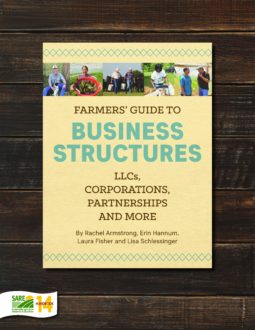Sole proprietorships do not have organizing documents. This would be rather futile–there’s just one owner, so they get to make all the decisions for how to run the operation and don’t need guidelines on voting and such. However, partnerships have the option to create a partnership agreement to outline the relationship. The partnership agreement allows the partners to establish the share of profits and losses that each partner will take, the responsibilities of each partner and what will happen to the business if a partner leaves. If a partnership agreement is not in place, or if it is not thorough, state partnership statutes will fill in the blanks and determine what rules govern in such scenarios. The benefit of having a partnership agreement is that you can decide what is best for your farm operation and your relationship, rather than relying on your state’s fallback rules.
Key issues to consider and include in a partnership agreement
The following highlights some important topics that farmers should discuss with their business partners and ideally put into writing through a partnership agreement:
- Contributions to the partnership. It’s essential that the partners decide and get in writing who’s going to contribute what to the partnership, whether it’s cash, property or services, as well as the ownership percentage each partner will have. So if John invested $60,000 and Joe invested $40,000, then John would have a 60 percent ownership interest.
- Allocation of profits and losses. The partners may have different financial needs and different ideas for how and when the company’s profits are divvied up. Will profits and losses be allocated to partners
in proportion to their ownership percentage in the farm operation? Who decides whether and how much of the profits are handed out to the partners as distributions versus being reinvested back into the farm operation? These financial issues are particularly important to resolve early on, as they have a tendency to cause a lot of internal dispute. - Partnership authority and decision-making. Without an agreement, any partner can bind the partnership without the consent of the other partner(s). For example, if a partnership agreement was in place that required both partners to agree before entering a significant debt on behalf of the company, John would have further protection against Joe’s poor decision to purchase the $30,000 greenhouse. There’s no perfect formula for partnerships. You may, for example, want to require a unanimous vote for every decision. Or, if this seems too challenging, you can require a unanimous vote for major decisions and allow each partner to make minor decisions on their own. If this is the case, you’ll need to set a parameter for what is a major and minor decision. For example, entering a debt for more than $10,000 dollars is a major decision.
- Admitting new partners. What if new partners want to come aboard? The initial partners should agree to a procedure that makes it easier when this issue arises.
- Withdrawal or death of a partner. For example, let’s say that John wants to leave the partnership with Joe. This raises a lot of questions, including what the time frame is for him to receive a return on his investment in the farm operation or his share of the company. He likely won’t want to just leave it all for Joe. So what assets might he expect to receive? How should the value of the business be determined in such a scenario? For example, if the farm operation was valued at $100,000 and John leaves, then he could expect to receive $60,000 in some form to reflect his 60 percent interest. If this is not all fleshed out in a partnership agreement, then the brothers may get snared in a serious argument.
- Resolving disputes. If you and your partner become deadlocked on an important issue, how is the issue resolved? Do you want to head straight to court? Oftentimes farm operations prefer an alternative dispute resolution, such as mediation or arbitration. The partnership agreement is the place to designate this.
While some of these issues are challenging, and most likely folks won’t want to talk about them, it’s best if partners take the time to work through them at the outset. Even if the state’s default partnership laws would work fine, going through the process of creating a partnership agreement will help create shared expectations and clearer lines of communication as well as make things much easier should these challenging issues arise. Overall, a partnership agreement can help foster a stronger, more resilient farm business for the long haul.
Refer to the LLC chapter in this Guide for further guidance and resources
A model partnership agreement is not provided in this Guide, as most farm operations prefer the LLC structure if they’re going to go through the trouble of creating an organizing document. The LLC is taxed the same way as the general partnership, and for all intents and purposes operates in a similar way. Also, the issues and contents of a partnership agreement and the LLC’s operating agreement are very similar. If you decide to stick with a general partnership but decide to prepare a partnership agreement, refer to the chapter on LLCs (Chapter 4). Section 1 of the LLC chapter includes a thorough discussion on what issues should be included in an operating agreement, which is for the most part the same for a general partnership. Section 2 includes two sample LLC operating agreements– Brief Operating Agreement for Married Couple Farm, LLC and Extensive Operating Agreement for Sun Sisters Farm, LLC–as well as a checklist: Preparing Your Farm’s Operating Agreement. These resources serve as helpful guides to preparing both an operating agreement and a partnership agreement.
